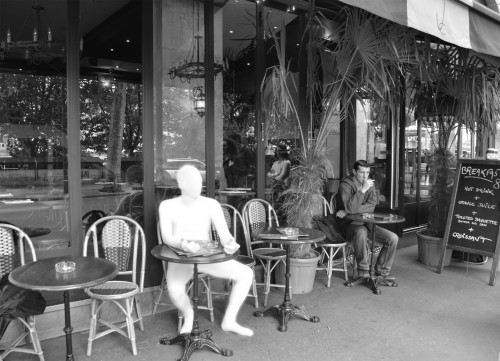A Review of Davis Schneiderman’s [SIC]
 [SIC]
[SIC]
by Davis Schneiderman
Jaded Ibis Press, October 2013
154 pages / $16 Buy from Jaded Ibis Press or Amazon
As an undergraduate, Professor Barrick (my physics instructor) taught me that white light is all of the colors combined; in painting, white is the absence of pigment – it is the anti-color. I lead off with this seemingly paradoxical tidbit about the shade? color? absence? white because white plays an important role in Davis Schneiderman’s new novel? conceptual art collection? book? book [SIC] (Jaded Ibis Press 2013), as it did in the first installation of his Dead/Books trilogy, BLANK (Jaded Ibis Press 2011).
In BLANK, white is the empty space on the pages that follows chapter titles representing common occurrences in common novels. “They meet” and “They fall in love” and “They fall apart” and “A character dies” are all there tantalizingly introducing nothing at all. The idea, of course, is to get us to think about the fact that no matter how clever the writing may be, the same damn things happen again and again. And just in case we believe it might all stop someday, there are even sections entitled “You die” and “I die,” though afterwards the book itself goes on.
The white in [SIC], however, is not a repetition of the previous work. For those who couldn’t imagine buying a book full of blank pages, here there is a heaping helping of words … none of them written directly for the project at hand except the Introduction (which, true to form, was not written by Davis Schneiderman, but by Daniel Levin Becker). And so [SIC] contains works in the public domain (some of my favorites being “Sinners in the Hands of an Angry God,” A Vindication of the Rights of Woman, and The Confidence Man), works not yet in the public domain which have been translated in and out of a dizzying array of languages (though back into English in the end), chain letters, songs, recipes, etc. all attributed to Davis Schneiderman.
With this glut of print, how could there possibly be any white? The white, in the case of [SIC], is found in Andi Olsen’s black & white photographs of Schneiderman in a white, Lycra bodysuit. The pictures depict famous landmarks (the Louvre, the Shakespeare & Co. bookstore), vacation scenes (a man buying postcards), everyday life (a man sitting at a restaurant), and even the more unfortunate parts of our lives (a man apparently kidnapping a child), but the focus is always on a glowing white void, the outline of or erasure of a person? alien? being. George Segal, in his tableaux, portrays people who are so anonymous they lack color, though they remain inherently human. The effect is melancholic: we wish these folks could find a way to break out of their plaster casts. Olsen’s photographs, on the other hand, are not about the human, they are about the post-human, or perhaps the not-quite-human. The glowing white entity in each picture may have two arms, two legs, and a head, but, in the end, it is only pretending? parodying? attempting? the human.
What is the effect of this combination of already published, though now newly attributed work and photographs depicting an eerie, white entity that may or may not be human? All colors and no color. By attributing every conceivable work to himself, Schneiderman makes himself the central figure in all of literature; by erasing himself from the photographs, however, he is saying that he doesn’t matter. Both the former and the latter are common writerly sentiments, though at different points in one’s career: I am important; I am no one. Their amalgamation, however, is revolutionary. To accept one’s presence and absence simultaneously is to accept the paradox of being an artist. I am everything art has led up to; I will be used as grist by future generations.
November 18th, 2013 / 11:00 am

